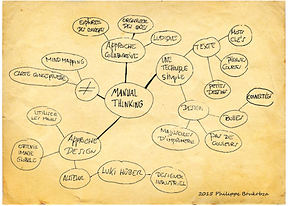SECTION 1
Empowerment as a Process,
not a Product
SESSION 3:
The Allegory of the Cave +
The Socratic Method +
Servant Leadership + Cultivating a Plan
____________
READ: Plato The Republic Book VII—Allegory of the Cave
This classic text uses the Socratic Method--questions to illicit deeper thinking--to share an allegory.
WRITE: Identify ONE of your grassroots goals + two practical steps toward that goal + three actions you can take to initiate/complete your practical steps.
WATCH: a short video on group brainstorming: https://www.interaction-design.org/literature/topics/brainstorming
Begin brainstorming ways to shape your GRASSROOTS PLAN to share on your WIX. Think back to Session 2 and your community change goal. What are key steps that you can include in a plan to reach one of your community change goals?
What are some ways you can brainstorm? There are many approaches to brainstorming as an individual and brainstorming in groups. Some folks call brainstorming "manual thinking" because you are physically engaged in chasing ideas as they cross your mind and capturing them on a page, chalk board, or document.
OPTIONS: You can make a list of ideas, then circle your favorite ones. You can write the goal at the middle of the page, then write ideas around it and begin to connect these with lines or circles. You can get artistic and create a mind map. You can set a clock and write ideas as fast as you can without worrying about punctuation or proper writing conventions. [Click on the images to the left to read more about manual thinking/brainstorming and mind mapping]
During our Zoom, you'll share your thoughts THEN we will brainstorm as a group. To get an idea of the sort of brainstorming we'll do on Zoom, watch "What is Brainstorming?": https://www.interaction-design.org/literature/topics/brainstorming
NOTE: You may have a way of brainstorming that works well for you. Use it. Be confident that you're learning which strategies and approaches work best for you. As part of our program, don't feel obligated to participate in an activity in exactly the way the person coordinating the session suggests. You have agency to make choices and approach activities like brainstorming on your own terms. Go above and beyond in the ways that lay a solid foundation for your grassroots initiatives.
More comments, below, on good research sources + Plato and The Allegory of the Cave.
Wikipedia is a fine starting point . . .
Don't quote from Wikipedia or
think of it as the definitive take on a subject. It's simply ground zero with basic information.
DO A LITTLE RESEARCH BEFORE YOU START READING CLASSICAL TEXTS, BUSINESS DOCUMENTS, and OTHER IMPORTANT MATERIALS
Before you tackle a new text, it's a good idea to find out a little more about the document. The Allegory of the Cave is a common reading, especially for educators. To learn more about some interpretations of the allegory, Wikipedia is a good place to start. Wikipedia is written by people like you and me who have expertise on a topic. Each item added to a wiki file is reviewed by editors as well as others with knowledge on the topic. Wikipedia is not an exhaustive source, but it's a good place to start and will include a bibliography of relevant sources at the end of the page that links you to other relevant internet-based sources.
As a rule of thumb, Wikipedia is a fine starting point to learn a little more about a document. Don't quote from Wikipedia or think of it as the definitive take on a subject. It's simply ground zero with basic information that can help you find the terminology to shape search terms and phrases to do more sophisticated research on the internet. You can also use tools like GoogleScholar to find in-depth, reputable sources that are peer reviewed. Peer review is common in all sorts of professional fields from medical studies to literature. When a publication is peer reviewed, experts in that same field have reviewed it carefully and agree that it is accurate and/or includes research strategies that are consistent with best practices in that field. Peer reviewed sources are usually accurate and reliable.
When you're on the internet, it's good to carefully examine sources to make sure they are factual and accurate. Sources that include .gov or .edu in the URL typically provide reliable information. Top news outlets like The New York Times, National Public Radio [NPR], the BBC, and Aljazeera provide carefully fact-checked, edited coverage of world events. Reading news sources like the BBC and Aljazeera provide a window into the way other parts of the world are looking at events here in the United States. But, for educational topics like Plato's allegory, .edu websites and academic journals are some of the best research options.
SOCRATES taught PLATO who taught ARISTOTLE
Visit the clickable timeline to see where these famous philosophers overlap in time. These three teachers are credited with laying the foundations for western philosophy, morality, and concepts of civility.
There are many, many writers who have explored Plato's allegory. Anam Ladhi has a short article with a traditional reading of Plato: https://medium.com/indian-thoughts/education-and-platos-allegory-of-the-cave-bf7471260c50
Other writers are less generous and comment on the shortcomings of the allegory, including his student Aristotle. We'll talk about his a little during our Zoom.





